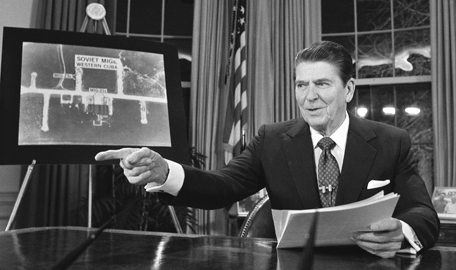On March 23, 1983, President Ronald Reagan proposed the development of the Strategic Defense Initiative (SDI), a space and ground-based defense system to intercept enemy nuclear missiles.
Reagan Announces Plan for SDI
In a nationally televised address, President Ronald Reagan called for the development of the Strategic Defense Initiative as a countermeasure to the threat of nuclear attack by the Soviet Union.
The proposed technology would move the United States away from the deterrent strategy of Mutually Assured Destruction, known by the acronym MAD, which hypothesized that neither country would launch an attack because the result would be the nuclear annihilation of both countries.
Reagan explained in his speech that the United States was not an aggressor, but rather that it drew strength from being prepared to defend itself. “What if free people could live secure in the knowledge that their security did not rest upon the threat of instant U.S. retaliation to deter a Soviet attack, that we could intercept and destroy strategic ballistic missiles before they reached our own soil or that of our allies?” he asked.
He mentioned his commitment to working with the Soviet Union to lower the level of nuclear arms and asked “the scientific community in our country, those who gave us nuclear weapons, to turn their great talents now to the cause of mankind and world peace, to give us the means of rendering these nuclear weapons impotent and obsolete.”
Reagan stated that he wanted to begin a “comprehensive and intensive effort to define a long-term research and development program to begin to achieve our ultimate goal of eliminating the threat posed by strategic nuclear missiles.”
Reagan’s plan was termed “Star Wars” by its critics, some of whom claimed that the technology for such a defense system did not exist. Others felt that the plan would accelerate the arms race.
After the Cold War came to an end, funding for the Strategic Defense Initiative was cut and the program was eventually reorganized and renamed several times. Though the initiative never resulted in the creation of the missile shield envisioned by Reagan, many useful defense systems were developed because of the SDI.
The Miller Center of Public Affairs provides video of Reagan’s speech.
Sources in this Story
- Time: Reagan for the Defense
- Nuclear Age Peace Foundation: Mutual Assured Destruction
- Federation of American Scientists: Address to the Nation on National Security By President Ronald Reagan, March 23, 1983
- Missile Defense Agency: History Resources
- University of Virginia: Miller Center for Public Affairs: Ronald Wilson Reagan
Biography: Ronald Reagan (1911–2004)
Reagan began his career not as a politician, but as a movie star. He served as governor of California and made two unsuccessful bids for the Republican presidential nomination in 1968 and 1976 before winning the 1980 presidential election against incumbent Jimmy Carter.
Reagan made national defense a priority, authorizing large increases in defense spending, including the creation of the SDI. The spending increased the national debt, but it had many benefits, explains the Miller Center for Public Affairs.
“First, the military upgraded and modernized its forces and equipment,” it writes. “Second, the money invested in military-related research and development proved a spur to certain segments of the economy, especially the high-tech sector. Finally, the increases in defense spending, coupled with promises that the American military would again be unsurpassed, boosted the confidence of the public.”
Reagan served two terms and, though his second term was tarnished by the Iran-Contra scandal, he left as one of the most popular presidents of the 20th century. He was diagnosed with Alzheimer’s disease in 1994 and died 10 years later on June 5, 2004, at the age of 93.
In 2012, we published this article about this historic event on The New York Times Learning Network. This article connected the event to current issues and offered reflection questions to help the reader think about its relevance today.











